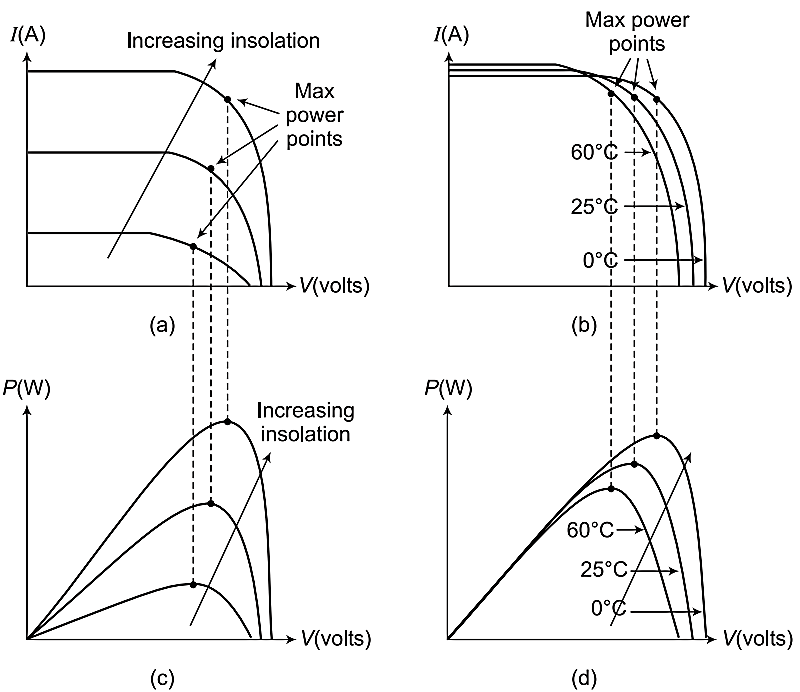Cell Properties and Design
Cell Properties and Design
Short Circuit Current: Maximum short circuit current will be obtained when there is no recombination in the material. It means that each photon will contribute to one electron flow to external circuit. In order to be absorbed, a photon is required to possess energy higher than the band gap of the material. Solar spectrum contains photons of varying energy (in the range 0.3 eV to 4.5 eV). A material with lower band gap will absorb more number of photons producing higher short circuit current. Thus, short current of solar cell increases with decrease in band gap. For Si, with band gap of 1.12 eV, the maximum possible short circuit current is 46 mA under photon flux of solar spectrum (AM1.5).
Open Circuit Voltage: A minimum value of reverse saturation current Io can be estimated in terms of band gap. Also, from Eq. (4) of Voc, it reveals that with increase in band gap, Io decreases, which results in increase in Voc.
Fill Factor: The best value of FF that can be obtained for a solar cell, as a function of Voc can be calculated using an empirical equation.
Good solar cells typically will have FF values of around 0.8.
Efficiency: The short circuit current decreases with increase in band gap, whereas open circuit voltage increases with increase in band gap. Thus, there is an optimum band gap for which the efficiency of solar cell would be maximum. Maximum efficiency of about 31 per cent is obtained for the optimum band gap of 1.45 eV for an ideal solar cell, under certain assumptions.
Effect of Variation of Insolation and Temperature: As the insolation keeps on varying throughout the day it is important to observe its effects on PV characteristics. If the spectral content of the radiation remains unaltered, and temperature and all other factors remain same, both Isc and Voc increase with increasing the intensity of radiation. The photo-generated current depends directly on insolation. Therefore, the short circuit current, depends linearly while open circuit voltage, depends logarithmically on the insolation. This is shown in Fig. 1.7(a,c).

Fig. 1.7: Effect of variation of (a) & (c) insolation and (b) & (d) temperature on the characteristic of solar cell
An illuminated PV cell converts only a small fraction (approx. less than 20 per cent) of irradiance into electrical energy. The balance is converted into heat, resulting into heating of the cell. As a result, the cell can be expected to operate above ambient temperature. Keeping insolation level as constant, if the temperature is increased, there is a marginal increase in the cell current but a marked reduction in the cell voltage. An increase in temperature causes reduction in the band gap. This in turn causes some increase in photo-generation rate and thus a marginal increase in current. However, the reverse saturation current increases rapidly with temperature. Due to this, the cell voltage decreases, depending on the resistivity of the silicon used: higher the silicon resistivity more marked is the temperature effect. Also, the fill factor decreases slightly with temperature. This is shown in Fig. 1.7(b, d).
Energy Losses and Efficiency: The conversion efficiency of a solar cell is the ratio of electrical power output to incident solar power. The optimum possible theoretical efficiency of 31 per cent for an ideal solar cell under ideal conditions is obtained at band gap of 1.45 eV. In laboratory studies, the highest reported conversion efficiency of a single crystal silicon solar cell is about 24 per cent. Conversion efficiencies of commercially produced single crystal solar cells are in the range 12–18 per cent.
Various loss mechanisms lead to limit the conversion efficiency of the cell. Some of these losses are due to inherent nature of internal physical processes and available input. These cannot be influenced by external means. The other category of losses can be influenced by suitable selection of material, processing technology and other parameters of the cell.
- Loss of Low Energy Photons
- Loss Due to Excess Energy Photons
- Voltage Loss
- Fill Factor Loss
- Loss by Reflection
- Loss Due to Incomplete Absorption
- Loss Due to Metal Coverage
- Recombination Losses
latest video
news via inbox
Nulla turp dis cursus. Integer liberos euismod pretium faucibua





